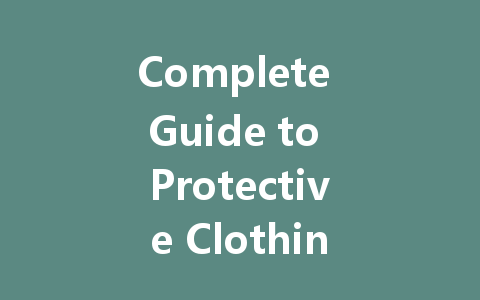Protective clothing plays a crucial role in ensuring safety across various industries. This article will explore the different types of protective clothing, their functions, and where to purchase them.
What is Protective Clothing?
Protective clothing refers to garments designed to safeguard the wearer from various hazards. These hazards can include chemical exposure, biological agents, extreme temperatures, and physical injuries. The primary goal of protective clothing is to minimize the risk of injury or illness in hazardous environments.
Types of Protective Clothing
Chemical protective clothing is designed to protect against hazardous chemicals. This type of clothing is often made from materials that are resistant to chemical penetration, ensuring that harmful substances do not come into contact with the skin. Common examples include chemical suits, gloves, and face shields.
Medical protective clothing is essential for healthcare workers, especially during procedures that involve exposure to bodily fluids. This category includes gowns, masks, gloves, and eye protection. These garments are designed to prevent contamination and protect both the healthcare provider and the patient.
Thermal protective clothing is used in environments with extreme temperatures, whether hot or cold. Firefighters, for example, wear thermal suits that protect them from high heat and flames. Similarly, workers in cold environments may wear insulated clothing to prevent hypothermia.
High-visibility clothing is crucial for workers in environments where visibility is limited, such as construction sites or roadwork. These garments are typically bright in color and feature reflective strips to ensure that the wearer is easily seen by others.
PPE encompasses a wide range of protective clothing and gear, including helmets, gloves, goggles, and respirators. This equipment is essential in various industries, including construction, manufacturing, and healthcare, to protect workers from specific hazards.
Functions of Protective Clothing
Protection from Hazards
The primary function of protective clothing is to shield the wearer from potential hazards. This includes protection from chemicals, biological agents, extreme temperatures, and physical injuries. By wearing appropriate protective clothing, individuals can significantly reduce their risk of harm.
Comfort and Mobility
While protection is essential, comfort and mobility are also crucial factors in the design of protective clothing. Many modern protective garments are designed to allow for ease of movement, ensuring that wearers can perform their tasks effectively without being hindered by their clothing.
Compliance with Regulations
In many industries, wearing protective clothing is not just a recommendation but a legal requirement. Compliance with safety regulations helps organizations avoid fines and ensures a safer working environment for all employees.
Where to Buy Protective Clothing
Online Retailers
One of the most convenient ways to purchase protective clothing is through online retailers. Websites specializing in safety gear often offer a wide range of products, allowing customers to compare prices and read reviews before making a purchase.
Local Safety Supply Stores
Local safety supply stores are another excellent option for purchasing protective clothing. These stores often have knowledgeable staff who can provide guidance on the best products for specific needs. Additionally, customers can try on garments to ensure a proper fit.
Manufacturer Direct
For businesses that require bulk orders, purchasing directly from manufacturers can be a cost-effective solution. Many manufacturers offer discounts for bulk purchases and can provide customized options to meet specific safety requirements.
Schlussfolgerung
Protective clothing is an essential component of workplace safety across various industries. Understanding the different types of protective clothing and their functions can help individuals make informed decisions about their safety gear. Whether purchasing online, at a local store, or directly from a manufacturer, ensuring that you have the right protective clothing is vital for maintaining safety in hazardous environments.

